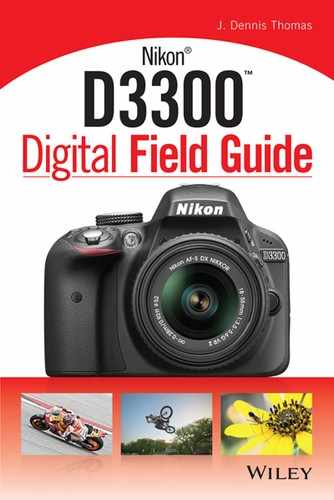Chapter 7: Working with the Live View and Video Modes
Live View and high-definition (HD) video are standard on all current Nikon dSLRs. When the D3000 was released, the video mode was left out so you had to buy the next model up to capture video, and while the D3100 added video, it was pretty much fully automatic and not truly high-definition. Now with the D3300, the video mode is actually more full featured than with any of the professional models. With the D3300, Nikon adds full 1080p video at 60 frames per second (fps) for seamless integration of slow-motion shots into footage shot at 1080p 30 fps. More importantly, the D3300 allows you to set the exposure manually for full control over the appearance and quality of your videos. As a result, the D3300 is much more viable as a dedicated HD video camera than many of its predecessors.
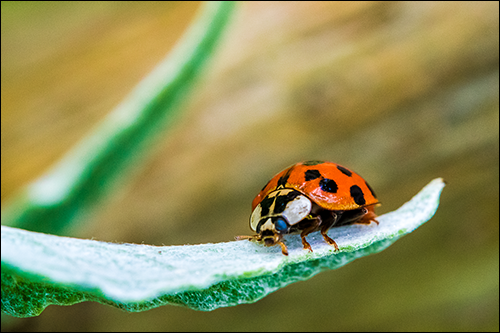
Using Live View mode, you can take your eye away from the viewfinder to compose your images on the 3-inch, high-resolution LCD monitor, which can help make it easier to get more interesting angles.
Live View Mode
Live View mode (![]() ) is simply a live feed of what is being projected through the lens and onto the sensor. This live feed can also be used to produce a video. To enter Live View mode (
) is simply a live feed of what is being projected through the lens and onto the sensor. This live feed can also be used to produce a video. To enter Live View mode (![]() ), press the Live View button (
), press the Live View button (![]() ) to activate it. The Live View button (
) to activate it. The Live View button (![]() ) is located right above the multi-selector. To shoot still photos, simply half-press the shutter-release button as you normally would to focus when using the viewfinder, and fully press the button to take the picture. To record video, press the movie-record button, which is located just behind and to the left of the shutter-release button.
) is located right above the multi-selector. To shoot still photos, simply half-press the shutter-release button as you normally would to focus when using the viewfinder, and fully press the button to take the picture. To record video, press the movie-record button, which is located just behind and to the left of the shutter-release button.
When you use Live View mode (![]() ), shooting stills and videos are very similar. Although each feature has some options that the other doesn’t have, I’m first going to cover the options they have in common.
), shooting stills and videos are very similar. Although each feature has some options that the other doesn’t have, I’m first going to cover the options they have in common.
Focus modes
The D3300 offers three focus modes when using Live View mode (![]() ). These modes are similar in some ways to those you find when using the traditional, through-the-viewfinder shooting method. When in Live View mode (
). These modes are similar in some ways to those you find when using the traditional, through-the-viewfinder shooting method. When in Live View mode (![]() ), you change the focus mode by pressing the i button (
), you change the focus mode by pressing the i button (![]() ) to enter the Info edit menu.
) to enter the Info edit menu.
To select a focus mode, use the multi-selector to navigate to the Focus mode option, and then press the OK button (![]() ). This presents you with three options: Single-servo AF (
). This presents you with three options: Single-servo AF (![]() ), Full-time-servo AF (
), Full-time-servo AF (![]() ), or Manual focus (
), or Manual focus (![]() ). You can also slide the focus mode switch on the lens to Manual (if the lens features one).
). You can also slide the focus mode switch on the lens to Manual (if the lens features one).
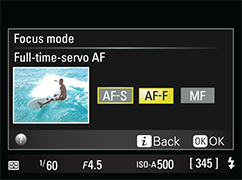
7.1 The focus modes in the Info edit menu.
Single-servo AF
This mode works the same in Live View as when using Single-servo AF (![]() ) for shooting stills traditionally with the viewfinder method. Press the multi-selector up (
) for shooting stills traditionally with the viewfinder method. Press the multi-selector up (![]() ), down (
), down (![]() ), right (
), right (![]() ), or left (
), or left (![]() ) to move the focus point to your subject, and then press the shutter-release button halfway to focus. Fully press the shutter-release button when the scene is in focus and ready to shoot. Note that the D3300 takes a still photo in Single-servo AF mode (
) to move the focus point to your subject, and then press the shutter-release button halfway to focus. Fully press the shutter-release button when the scene is in focus and ready to shoot. Note that the D3300 takes a still photo in Single-servo AF mode (![]() ) even if the scene is out of focus when the shutter-release button is fully pressed.
) even if the scene is out of focus when the shutter-release button is fully pressed.
You follow the same procedure for video, except that you press the movie-record button, located just behind and to the left of the shutter-release button, to start recording video. You can do this in two ways: one is to focus first, and then start recording; the other is to start recording out of focus, and then press the shutter-release button halfway to focus in for a cinematic pull focus effect (this technique works a lot better in manual focus, however). Once the camera locks focus, it stays focused at that distance unless you press the shutter-release button again.
For still photography, I recommend using Single-servo AF (![]() ) for stationary subjects like portraits, still life, products, and landscapes. For video, you need to be sure that your subject isn’t moving backward or forward by a large margin, especially if you’re using a wide aperture for a shallow depth of field. Even the slightest change in distance can cause the subject to go out of focus. This setting is good for recording interviews or shooting scenes where there is not much back-and-forth subject movement.
) for stationary subjects like portraits, still life, products, and landscapes. For video, you need to be sure that your subject isn’t moving backward or forward by a large margin, especially if you’re using a wide aperture for a shallow depth of field. Even the slightest change in distance can cause the subject to go out of focus. This setting is good for recording interviews or shooting scenes where there is not much back-and-forth subject movement.
Full-time-servo AF
Full-time-servo AF mode (![]() ) allows the camera to focus continuously, similar to when the shutter-release button is pressed halfway in Continuous-servo AF mode (
) allows the camera to focus continuously, similar to when the shutter-release button is pressed halfway in Continuous-servo AF mode (![]() ).
).
When using Full-time-servo AF mode (![]() ) while recording video, you should be aware that the camera often hunts for focus, especially if you are moving or panning the camera. This can cause the video to go in and out of focus during your filming, which can cause your videos to look unprofessional (although some mockumentary videos use this for effect).
) while recording video, you should be aware that the camera often hunts for focus, especially if you are moving or panning the camera. This can cause the video to go in and out of focus during your filming, which can cause your videos to look unprofessional (although some mockumentary videos use this for effect).
The Autofocus modes, and the Single-servo AF (![]() ) and Full-time-servo AF (
) and Full-time-servo AF (![]() ) modes, operate in conjunction with the AF-area modes, which are covered in the next section.
) modes, operate in conjunction with the AF-area modes, which are covered in the next section.
AF-area modes
To enable you to focus more quickly and easily in Live View mode (![]() ), Nikon gives you different options for AF-area modes. The AF-area modes are different from the traditional through-the-viewfinder shooting AF-area modes. When in Live View mode (
), Nikon gives you different options for AF-area modes. The AF-area modes are different from the traditional through-the-viewfinder shooting AF-area modes. When in Live View mode (![]() ), you change the focus modes by pressing the i button (
), you change the focus modes by pressing the i button (![]() ) to enter the Info edit menu. Use the multi-selector to navigate to the AF-area mode option, and then press the OK button (
) to enter the Info edit menu. Use the multi-selector to navigate to the AF-area mode option, and then press the OK button (![]() ).
).
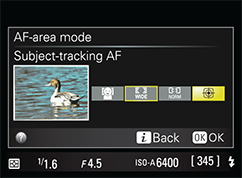
7.2 The AF-area modes in the Info edit menu.
The following options are found under AF-area mode:
- Face-priority AF mode (
 ). Use this mode for shooting portraits or snapshots of the family. You can choose the focus point, but the camera uses face recognition to focus on the face rather than something in the foreground or background. This can really be an asset when shooting in a busy environment, such as when a lot of distracting elements are in the background.
). Use this mode for shooting portraits or snapshots of the family. You can choose the focus point, but the camera uses face recognition to focus on the face rather than something in the foreground or background. This can really be an asset when shooting in a busy environment, such as when a lot of distracting elements are in the background.
When the camera detects a face in the frame, a double yellow border is displayed around the autofocus area. If the D3300 detects more than one face (the camera can read up to 35 faces), then it chooses the closest face as the primary focus point. You can use the multi-selector to choose a different primary face if you desire. When you use Face-priority AF mode (
 ) to capture group shots, I suggest using an aperture of f/5.6 or smaller to ensure greater depth of field to get all the faces in focus.
) to capture group shots, I suggest using an aperture of f/5.6 or smaller to ensure greater depth of field to get all the faces in focus.When using Face-priority mode with more than one face in the scene, the primary face is shown with a double border around the AF area.
- Wide-area AF mode (
 ). This mode makes the area from where the camera determines focus about four times the size of the Normal-area AF mode (
). This mode makes the area from where the camera determines focus about four times the size of the Normal-area AF mode ( ). This is good when you don’t need to be very critical about the point of focus in your image. For example, when shooting a far-off landscape, you really only need to focus on the horizon line. This is a good general mode for everyday use. You can move the autofocus area anywhere within the image frame.
). This is good when you don’t need to be very critical about the point of focus in your image. For example, when shooting a far-off landscape, you really only need to focus on the horizon line. This is a good general mode for everyday use. You can move the autofocus area anywhere within the image frame.
When using the Face-priority AF (
 ), Normal-area AF (
), Normal-area AF ( ), or Wide-area AF (
), or Wide-area AF ( ) modes in Live View mode (
) modes in Live View mode ( ), press the OK button (
), press the OK button ( ) to quickly return the autofocus area to the center of the frame.
) to quickly return the autofocus area to the center of the frame. - Normal-area AF mode (
 ). This mode has a smaller autofocus point than Wide-area AF mode (
). This mode has a smaller autofocus point than Wide-area AF mode ( ), and you use it when you need to achieve focus on a very specific or precise area within the frame. This is the preferred mode when shooting with a tripod, or when shooting macros, still life shots, or portraits that require a more precise focus than Face-priority AF mode (
), and you use it when you need to achieve focus on a very specific or precise area within the frame. This is the preferred mode when shooting with a tripod, or when shooting macros, still life shots, or portraits that require a more precise focus than Face-priority AF mode ( ) provides (generally, portraits are focused on the eye closest to the camera).
) provides (generally, portraits are focused on the eye closest to the camera). - Subject-tracking AF mode (
 ). This is an interesting feature, especially when used in conjunction with video. Use the multi-selector to position the autofocus area over the top of the main subject in the image. Focus on the subject, and then press the OK button (
). This is an interesting feature, especially when used in conjunction with video. Use the multi-selector to position the autofocus area over the top of the main subject in the image. Focus on the subject, and then press the OK button ( ) to start tracking the subject. The autofocus area follows the subject as it moves around within the frame. Be aware, however, that this feature works best with slow to moderately paced subjects that stand out from the background. When using Subject-tracking AF mode (
) to start tracking the subject. The autofocus area follows the subject as it moves around within the frame. Be aware, however, that this feature works best with slow to moderately paced subjects that stand out from the background. When using Subject-tracking AF mode ( ) with a very fast-moving subject, the camera tends to lose the subject and lock onto something of a similar color and brightness within the frame. This mode also becomes less effective as the amount of light decreases. To disable subject tracking, simply press the OK button (
) with a very fast-moving subject, the camera tends to lose the subject and lock onto something of a similar color and brightness within the frame. This mode also becomes less effective as the amount of light decreases. To disable subject tracking, simply press the OK button ( ). This resets the autofocus area to the center. To reactivate Subject-tracking AF mode (
). This resets the autofocus area to the center. To reactivate Subject-tracking AF mode ( ), press the OK button (
), press the OK button ( ) again.
) again.
All AF-area modes are disabled when you set the camera or lens to Manual focus (![]() ), or when you attach a manual focus or non-AF-S lens to the D3300.
), or when you attach a manual focus or non-AF-S lens to the D3300.
Using Live View mode
As you may already know, the image from the lens is projected to the viewfinder via a mirror that is in front of the sensor. There’s a semitransparent area in the mirror that acts as a beam splitter, which the camera uses for its normal phase-detection autofocus. For Live View mode (![]() ) to work, the mirror must be flipped up, which makes phase-detection autofocus unusable, so the camera uses contrast detection directly from the sensor to determine focus. This makes focusing in Live View mode (
) to work, the mirror must be flipped up, which makes phase-detection autofocus unusable, so the camera uses contrast detection directly from the sensor to determine focus. This makes focusing in Live View mode (![]() ) a bit slower than focusing normally. In addition, when you’re shooting stills, the mirror must flip down and back up, which takes some extra time. This makes Live View mode (
) a bit slower than focusing normally. In addition, when you’re shooting stills, the mirror must flip down and back up, which takes some extra time. This makes Live View mode (![]() ) a more challenging option to use when shooting moving subjects or events such as sports, where timing is the key element in capturing an image successfully.
) a more challenging option to use when shooting moving subjects or events such as sports, where timing is the key element in capturing an image successfully.
That being said, Live View mode (![]() ) is ideal when shooting in a controlled environment or studio setting, especially when using a tripod. You can move the focus area anywhere within the frame; you’re not limited to the 11-point autofocus array. Using Live View mode (
) is ideal when shooting in a controlled environment or studio setting, especially when using a tripod. You can move the focus area anywhere within the frame; you’re not limited to the 11-point autofocus array. Using Live View mode (![]() ) also allows you to achieve sharper images when doing long exposures because the mirror is already raised, eliminating any chance of mirror slap, which can sometimes cause images to blur slightly when shooting exposures longer than 1/2 second.
) also allows you to achieve sharper images when doing long exposures because the mirror is already raised, eliminating any chance of mirror slap, which can sometimes cause images to blur slightly when shooting exposures longer than 1/2 second.
Keep in mind that if you hold the camera at arm's length when it's in Live View mode (![]() ), you increase the risk of blurry images due to added camera shake. Keep your elbows close to your sides for added stability.
), you increase the risk of blurry images due to added camera shake. Keep your elbows close to your sides for added stability.
Shooting still photographs in Live View mode (![]() ) is very simple. Just press the Live View button to activate Live View mode (
) is very simple. Just press the Live View button to activate Live View mode (![]() ) and you’re ready to shoot. Use the multi-selector up (
) and you’re ready to shoot. Use the multi-selector up (![]() ), down (
), down (![]() ), right (
), right (![]() ), or left (
), or left (![]() ) to position the focus point. When in Single-servo AF mode (
) to position the focus point. When in Single-servo AF mode (![]() ), press the shutter-release button halfway to focus; in Full-time-servo AF mode (
), press the shutter-release button halfway to focus; in Full-time-servo AF mode (![]() ), wait until the camera achieves focus (you see a green square when the scene is in focus), and then fully press the shutter-release button to take the picture. To shoot video, follow the same procedure, except when you want to start filming, press the movie-record button.
), wait until the camera achieves focus (you see a green square when the scene is in focus), and then fully press the shutter-release button to take the picture. To shoot video, follow the same procedure, except when you want to start filming, press the movie-record button.
When using Full-time-servo AF mode (![]() ), pressing the shutter-release button causes the camera to refocus before actually taking the photo.
), pressing the shutter-release button causes the camera to refocus before actually taking the photo.
When filming video, fully depressing the shutter-release button causes the D3300 to shoot a still frame and ends video recording.
When in Live View mode (![]() ), the following buttons on top of the camera behave a little differently than they do when in the default viewfinder shooting mode:
), the following buttons on top of the camera behave a little differently than they do when in the default viewfinder shooting mode:
- Exposure compensation (
 )/Aperture (
)/Aperture ( ) button. Press this button and rotate the Command dial to adjust the aperture setting when in Manual mode (
) button. Press this button and rotate the Command dial to adjust the aperture setting when in Manual mode ( ). It adjusts the exposure compensation when in the Programmed auto (
). It adjusts the exposure compensation when in the Programmed auto ( ), Shutter-priority auto (
), Shutter-priority auto ( ), or Aperture-priority auto (
), or Aperture-priority auto ( ) modes.
) modes. - Movie-record button. This button’s only function is to start recording video when it’s pressed and to stop when it’s pressed a second time. Simple. It’s located just behind and to the left of the shutter-release button.
- Info button (
 ). Pressing this button cycles through a number of options for viewing the information laid over the Live View feed on the LCD monitor. These Live View/Movie Recording Display options are as follows:
). Pressing this button cycles through a number of options for viewing the information laid over the Live View feed on the LCD monitor. These Live View/Movie Recording Display options are as follows:
- Show photo indicators. As the name suggests, this is the information you need to see when using Live View mode (
 ) to shoot still photos (see figure 7.3).
) to shoot still photos (see figure 7.3). - Show movie indicators. This information display, shown in figure 7.4, shows settings relevant to filming video. This viewing option also has the 16:9 aspect ratio in clear view with the rest of the frame grayed out so you can accurately frame your videos to the correct aspect before you press the movie-record button.
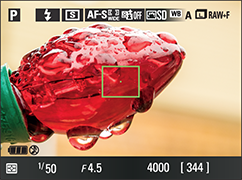
7.3 The Show photo indicators option.
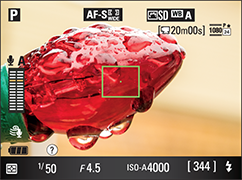
7.4 The Show movie indicators option.
When the camera is set to record video at 640 × 424, the grayed-out crop area isn’t shown, as the aspect ratio is 3:2 like a standard photo.
- Hide indicators. This option hides all of the extraneous setting indicators in the frame and gives you a clear view so you can frame your shot without distractions. Small brackets are visible for use in lining up the shot to a 16:9 aspect ratio.
- Framing grid. This option is similar to Hide indicators, with the addition of a grid, as shown in figure 7.5. The grid is helpful for keeping lines or horizons straight in your compositions, or helping to compose with the Rule of Thirds. The shooting information is still displayed on the bottom.
- Show photo indicators. As the name suggests, this is the information you need to see when using Live View mode (
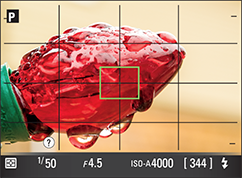
7.5 The Framing grid option displays the same information found in the Hide indicators option with the addition of a grid to aid in composition.
Although you can shoot stills or video when the camera is in any of the Live View/Movie Recording Display options, I recommend setting the display option for your intended recording. For example, set it to Show photo indicators for shooting stills and set it to Show movie indicators for filming video. This may seem like a no-brainer, but it’s definitely a good habit to get into.
The buttons on the back of the camera also have some features when using Live View mode (![]() ). Here are the options:
). Here are the options:
- Playback button (
 ). Press this button to review your images or videos. Press it again to return to Live View mode (
). Press this button to review your images or videos. Press it again to return to Live View mode ( ).
). - Menu button (
 ). Press this button to access the menu system. Not all options are available. Press the Menu button (
). Press this button to access the menu system. Not all options are available. Press the Menu button ( ) again to return to Live View mode (
) again to return to Live View mode ( ).
). - Zoom in button (
 ). Press this button to zoom in on your focus point to check focus.
). Press this button to zoom in on your focus point to check focus. - Thumbnail/Zoom out button (
 ). Press this button to zoom out when you’re back to the standard framing; the shooting information bar reappears at the bottom of the screen.
). Press this button to zoom out when you’re back to the standard framing; the shooting information bar reappears at the bottom of the screen. - i button (
 ). A single press of this button brings up the Info edit menu. Press the i button (
). A single press of this button brings up the Info edit menu. Press the i button ( ) again to return to Live View mode (
) again to return to Live View mode ( ).
). - AE-L/AF-L button (
 ). This button functions as assigned in Custom Setting menu (
). This button functions as assigned in Custom Setting menu ( ) f2 when you press it.
) f2 when you press it.
Shooting and Editing Video
Using the video feature on the D3300 is quite simple: press the Live View button (![]() ), focus, and then press the movie-record button. Easy now, Tarantino. Before you hit that Record button, you need to set up the camera.
), focus, and then press the movie-record button. Easy now, Tarantino. Before you hit that Record button, you need to set up the camera.
First, press the Menu button (![]() ) to enter the menu system. Use the multi-selector to navigate to the Shooting menu (
) to enter the menu system. Use the multi-selector to navigate to the Shooting menu (![]() ), press the OK button (
), press the OK button (![]() ), and then navigate to the Movie settings option. This is the very last menu item. Press the OK button (
), and then navigate to the Movie settings option. This is the very last menu item. Press the OK button (![]() ) and you’re faced with the following options:
) and you’re faced with the following options:
- Frame size/frame rate. Choose the image size based on your intended output and preferred frame rate (covered later in this chapter). You have the following choices:
- 1920 × 1080; 60p (
 )
) - 1920 × 1080; 30p (
 )
) - 1920 × 1080; 24p (
 )
) - 1280 × 720; 60p (
 )
) - 640 × 424; 30p (
 )
)
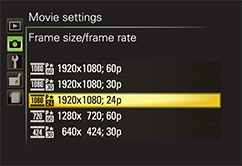
7.6 The Frame size/frame rate screen.
- 1920 × 1080; 60p (
- Movie quality. You have two choices: High and Normal. The difference comes down to bit rate. At higher bit rates, more information is being recorded, resulting in better color rendition and dynamic range; of course, higher bit rates also mean more data and larger file sizes. Keep in mind that High quality movie clips are limited to 20 minutes and Normal quality clips can be up to 29 minutes and 59 seconds. Again, your choice comes down to your intended output. For the web, Normal quality is fine; for viewing on HDTVs, stick with High quality. Notice that when the quality is set to High, a small star appears in the Frame size/frame rate icon.
- Microphone. The three microphone settings are Auto sensitivity, Manual sensitivity, and Microphone off. Auto works for most general filming, but for a more consistent sound in a controlled environment, you can set the microphone sensitivity manually. You can monitor the levels when filming. When recording sound to an external source, you may want to turn the microphone off. Most professional filmmakers prefer to record the audio to a separate file using a dedicated sound recording system for higher audio quality. The video and sound files are later synced in postproduction.
- Manual movie settings. When this option is set to the default (which is Off), the camera completely controls the shutter speed and ISO setting, no matter what the settings say in the information display. Set this option to On if you want to set the shutter speed and ISO manually when in Manual exposure mode (
 ).
).
When you set the Manual movie settings to On, Auto ISO (![]() ) is disabled for video.
) is disabled for video.
Now that the Movie settings are taken care of, you should set the following options:
- Picture Control. As it does with your still images, the D3300 applies Picture Control settings to your movie. You can also create and use Custom Picture Controls that fit your specific application. One of my favorites is a Custom Picture Control that I created called Raging Bull; it uses the Monochrome Picture Control (
 ) with added contrast and the yellow filter option. This gives me a black-and-white scene that’s reminiscent of the Martin Scorsese film of the same name. Before you start recording your video, decide which Picture Control you want to use for your movie.
) with added contrast and the yellow filter option. This gives me a black-and-white scene that’s reminiscent of the Martin Scorsese film of the same name. Before you start recording your video, decide which Picture Control you want to use for your movie. - Exposure mode. If you set the Manual movie settings to On, this is a very important setting. The exposure mode you select determines whether you or the camera will be choosing the settings. Select one of the following options:
- Programmed auto (
 ) and Shutter-priority auto (
) and Shutter-priority auto ( ) modes. These modes let the camera make all the exposure choices for you. When you press the Live View button (
) modes. These modes let the camera make all the exposure choices for you. When you press the Live View button ( ), the camera sets the shutter speed, aperture, and ISO sensitivity. While you’re filming, if the lighting changes, the camera adjusts the exposure by adjusting the ISO sensitivity. If the scene becomes too bright, the shutter speed is raised to keep a good exposure unless you lock the exposure by pressing the AE-L/AF-L button (
), the camera sets the shutter speed, aperture, and ISO sensitivity. While you’re filming, if the lighting changes, the camera adjusts the exposure by adjusting the ISO sensitivity. If the scene becomes too bright, the shutter speed is raised to keep a good exposure unless you lock the exposure by pressing the AE-L/AF-L button ( ). The only control you have over the exposure is that you can adjust the Exposure compensation (
). The only control you have over the exposure is that you can adjust the Exposure compensation ( ).
).
It’s important to note that when the camera is set to Shutter Priority auto (
 ), the shutter speed is automatically overridden by the camera as soon as the movie-record button is pressed.
), the shutter speed is automatically overridden by the camera as soon as the movie-record button is pressed. - Aperture-priority auto mode (
 ). This mode allows you a little more control. You can set the aperture to control the depth of field, but the camera automatically controls the shutter speed and the ISO sensitivity. You can also use Exposure compensation (
). This mode allows you a little more control. You can set the aperture to control the depth of field, but the camera automatically controls the shutter speed and the ISO sensitivity. You can also use Exposure compensation ( ) to brighten or darken the image.
) to brighten or darken the image. - Manual mode (
 ). If you’re serious about video, you should be using this exposure mode. This mode lets you control the exposure by adjusting the aperture, shutter speed, and ISO setting yourself. It takes a little more time to set up, but this allows you to control not only the depth of field but also the amount of noise and the shutter speed effect if you want.
). If you’re serious about video, you should be using this exposure mode. This mode lets you control the exposure by adjusting the aperture, shutter speed, and ISO setting yourself. It takes a little more time to set up, but this allows you to control not only the depth of field but also the amount of noise and the shutter speed effect if you want.
- Programmed auto (
When shooting using Manual exposure (![]() ) and Aperture Priority auto (
) and Aperture Priority auto (![]() ) mode, the aperture must be set before Live View mode (
) mode, the aperture must be set before Live View mode (![]() ) is activated.
) is activated.
When shooting in Manual exposure mode (![]() ), set the Function button (
), set the Function button (![]() ) to ISO so you can adjust the ISO settings quickly.
) to ISO so you can adjust the ISO settings quickly.
Frame size and frame rate
The D3300 offers a few options for recording video. There are two size settings for HD video with three frame rate options, and one option for shooting smaller videos that are destined directly for the web or e-mail. The high-definition (HD) video sizes are 1920 × 1080 and 1280 × 720. The small size is 640 × 424. When people discuss video frame size, they usually refer to the height number (1080 or 720) because of the way the image is progressively recorded (from top to bottom), but more on that later.
The 1080 video size has more resolution and therefore holds more detail and has less noise in low light. Most professionals prefer to shoot in 1080 and downsize later if necessary. There are, however, some reasons for shooting in 720. For example, the file sizes are smaller and, if you’re only shooting videos to post to YouTube or Vimeo or some other online source, you don’t really need the higher resolution. If you plan to make DVDs to show on an HDTV, then the extra resolution of 1080p is going to make quite a difference in quality. So, it boils down to your intended output. If you’re just planning on e-mailing to friends or just want to shoot a small-size file to be viewed on a laptop or mobile phone, you can use the smallest option of 640 × 424.
An important part of video capture is frame rate. This is the rate at which the still images are recorded, and it is expressed in terms of frames per second (fps). At the end of the resolution number (1080 or 720), there is another number in subscript (24, 25, 30, 50, or 60). This subscript number is the frame rate. Video capture involves recording still images, linking them together, and then playing them back one after another in sequence. This allows the still images to appear as if they’re moving. Most video cameras capture video at 30 or 60 fps. A rate of 30 fps is generally considered the best for smooth-looking video. Shooting at 24 fps is the minimum rate required to fool the human eye into seeing seamless motion. This is the frame rate that film-based motion pictures use, so 24 fps gives HD video a cinema-like quality.
The frame rate you select depends on a few factors. Most seasoned videographers prefer 30 fps for the smooth video look and the way that it portrays motion more naturally. Some videographers like to use 60 fps as well. This frame rate is generally used when shooting fast action or doing many quick pans, as the faster minimum shutter speed allows the camera to eliminate artifacts such as skew (where the subjects appear to slant as the camera pans) that can occur when doing a fast pan. When shooting fast action such as sports, most videographers will recommend 60 fps. Shooting at 60 fps is also a way in which videographers can create smooth slow motion by slowing the 60 fps footage down to 30 fps and using it with the regular footage that was shot at 30 fps.
Some filmmakers who started out using film and have recently transitioned to HDSLR video prefer the 24 fps film look. This is also the preferred frame rate if the footage is going to be intercut with footage that was digitized from actual film stock.
In-camera video editing
You can make simple edits to your videos in-camera. However, for more serious edits, you should consider third-party software such as iMovie for Mac or Adobe Premiere Elements for Mac or PC. These are affordable, entry-level editing programs. As you progress, though, you may need to step up to more powerful programs, such as Final Cut Pro X from Apple or Adobe Premiere Pro. In-camera, you have three options: choose the Start frame, choose the End frame, and grab a still image from the video. Each edit you make is saved as a new file, so there’s no need to worry about making any permanent changes to your original file. To edit a video, follow these steps:
- Press the Menu button (
 ) and use the multi-selector to select the Retouch menu (
) and use the multi-selector to select the Retouch menu ( ).
).
You can also press the Playback button (
 ), select the video using the multi-selector, and then press the i button (
), select the video using the multi-selector, and then press the i button ( ) and select the Edit movie option.
) and select the Edit movie option. - Select Edit Movie, and then press the OK button (
 ) or the multi-selector right (
) or the multi-selector right ( ) to view the menu options. Use the multi-selector to choose the movies. You can also use the Playback zoom-in button (
) to view the menu options. Use the multi-selector to choose the movies. You can also use the Playback zoom-in button ( ) to get a closer look at the initial still frame. Press the OK (
) to get a closer look at the initial still frame. Press the OK ( ) button to select the movie you want to edit.
) button to select the movie you want to edit. - Choose the type of edit that you want to make, and then press the OK button (
 ) or the multi-selector right (
) or the multi-selector right ( ). The options are Choose start point / end point, or Save selected frame. A menu appears with all videos that are saved to the current memory card (when the movie is selected directly from the Playback screen, this option doesn’t appear).
). The options are Choose start point / end point, or Save selected frame. A menu appears with all videos that are saved to the current memory card (when the movie is selected directly from the Playback screen, this option doesn’t appear). - Use the multi-selector to scroll through the available videos until the one you want is highlighted in yellow, and then press the OK button (
 ).
). - Press the OK button (
 ) to begin playback, and then press the multi-selector up (
) to begin playback, and then press the multi-selector up ( ) at the point in the video where you want to make the edit. You can press the multi-selector down (
) at the point in the video where you want to make the edit. You can press the multi-selector down ( ) to stop playback, and multi-selector left (
) to stop playback, and multi-selector left ( ) or right (
) or right ( ) to go back or forward in the video clip.
) to go back or forward in the video clip. - Press the multi-selector up (
 ) to make the edit. I prefer to pause the movie by pressing the multi-selector down (
) to make the edit. I prefer to pause the movie by pressing the multi-selector down ( ) so I can be absolutely sure it is where I want the edit to be. I then make the edit and the movie saves automatically.
) so I can be absolutely sure it is where I want the edit to be. I then make the edit and the movie saves automatically.
When playing back a movie file, you can use the Command dial to jump ahead in 10-second increments. If the clip is less than 10 seconds long, it jumps to the end of the clip.
